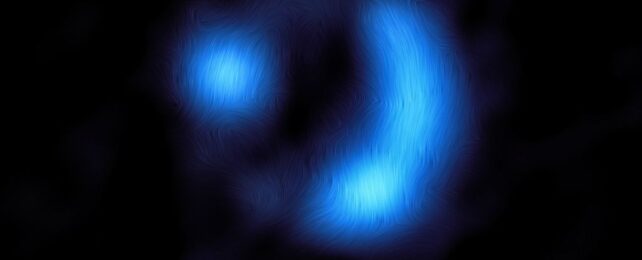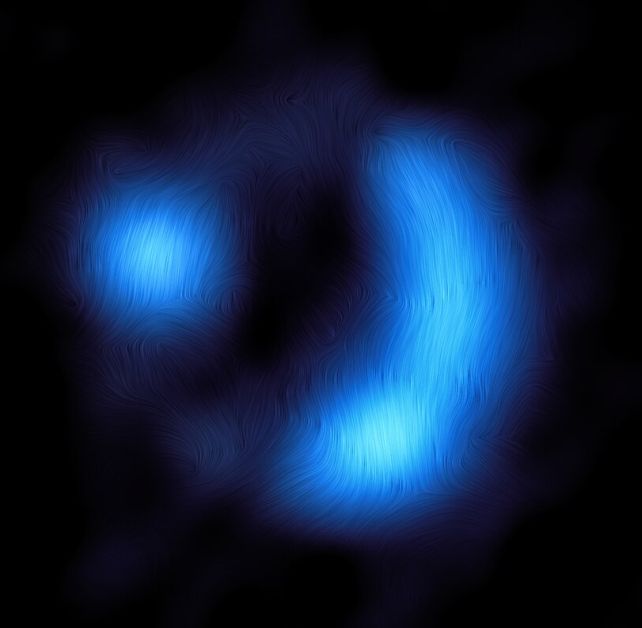 Magnetic field map of the distant galaxy 9io9, using data from the Atacama Large Millimeter/submillimeter Array. (ALMA (ESO/NAOJ/NRAO)/J. Geach et al.)
Magnetic field map of the distant galaxy 9io9, using data from the Atacama Large Millimeter/submillimeter Array. (ALMA (ESO/NAOJ/NRAO)/J. Geach et al.)
Using light that has traveled for more than 11 billion years to reach us, scientists have just measured the most distant magnetic field yet.
It was emitted by a galaxy called 9io9, which appears as it was just 2.5 billion years after the Big Bang. Mapping its lines should help astronomers understand how galaxies spin the giant magnetic fields that run through and around them in the Universe's infancy.
"Many people might not be aware that our entire galaxy and other galaxies are laced with magnetic fields, spanning tens of thousands of light-years," says astrophysicist James Geach of the University of Hertfordshire in the UK.
"This discovery gives us new clues as to how galactic-scale magnetic fields are formed."
Magnetic fields are common throughout the Universe. They are commonly powered by the flow of electrically conductive material converting kinetic energy into magnetic energy in what's known as a dynamo effect. Earth's magnetic field is generated by fluid sloshing around inside it, for example.

Galactic magnetic fields are thought to be generated in a similar manner. The galaxy rotates, and the charged gas inside it rotates too. This motion maintains the galactic magnetic field, but it's a much weaker magnetic field than you'll find around Earth, or the Sun. The Milky Way's magnetic field has been measured at between 25 and 60 microgauss, for example; Earth's is between 0.22 and 0.67 gauss at the surface.
However, we don't know how galactic magnetic fields get started in the first place. Are they created from a top-down process, inherited from the wider Universe where they form? Or do the magnetic fields emerge from a bottom-up process, from the stuff that forms in the galaxy generating the magnetic fields that then permeate it?
The discovery of the magnetic field of 9io9 gives us some clues.
The galaxy was magnified by the presence of a foreground mass that bends space-time, allowing Geach and his colleagues to measure the polarization of its light. This is when the wavelength of light becomes strongly oriented in a particular direction as it travels through a magnetic field.
Based on the light's analysis, the magnetic field of 9io9 was similar to those in galaxies nearby. It even showed comparable strength, 500 microgauss or lower. That's about 1,000 times weaker than Earth's magnetic field.
This suggests the magnetic field formed rapidly while the galaxy was still growing, implying galactic magnetic fields are strongly linked to material that is forming new stars.
The team believes that star formation – often occurring at a furious rate in the early Universe – can help accelerate the growth and development of galactic magnetic fields.
In turn, the magnetic fields can then influence subsequent star formation.
The discovery, the researchers say, offers a new window into the inner workings of galaxies in a crucial time in the evolution of the Universe.
The research has been published in Nature.




0 Comments